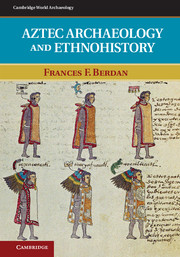Book contents
- Frontmatter
- Contents
- List of figures
- List of tables
- List of cases
- Acknowledgments
- A Word about Terminologies
- Nahuatl Pronunciation Guide
- Part 1 Setting the Stage
- Part 2 Aztec Society and Culture
- Chapter 3 Living on the Land
- Chapter 4 Craft Specialization, Commerce, and Trade
- Chapter 5 City-States and Imperial Rule
- Chapter 6 Living as an Aztec: Social Status and Daily Life
- Chapter 7 Religion, Science, and the Arts
- Chapter 8 The Aztec World: An Integrated View
- Glossary
- Notes
- References
- Index
Chapter 4 - Craft Specialization, Commerce, and Trade
Published online by Cambridge University Press: 05 July 2014
- Frontmatter
- Contents
- List of figures
- List of tables
- List of cases
- Acknowledgments
- A Word about Terminologies
- Nahuatl Pronunciation Guide
- Part 1 Setting the Stage
- Part 2 Aztec Society and Culture
- Chapter 3 Living on the Land
- Chapter 4 Craft Specialization, Commerce, and Trade
- Chapter 5 City-States and Imperial Rule
- Chapter 6 Living as an Aztec: Social Status and Daily Life
- Chapter 7 Religion, Science, and the Arts
- Chapter 8 The Aztec World: An Integrated View
- Glossary
- Notes
- References
- Index
Summary
And at the beginning, when the infant was taken to be bathed, if it was a boy, they carried him with his symbol in his hand; and the symbol was the tool used by the infant’s father, whether of the military or professions like metalworker, woodcarver, or whatever other profession.... And if the infant was a girl, the symbol they gave her for bathing was a distaff with its spindle and its basket, and a broom, which were the things she would use when she grew up.
Codex Mendoza, folio 56v (Berdan and Anawalt 1992: vol. 4, 118); originally written ca. 1541The merchant is a seller, a merchandiser, a retailer; (he is) one who profits, who gains; who has reached an agreement on prices; who secures increase, who multiplies (his possessions).... The good merchant (is) a follower of the routes, a traveler.
Sahagún 1950–1982: book 10, 42–43; originally written 1575–1577 or 1578–1580The Aztec world was a world of specialists. In the political sphere there were royal advisers, ambassadors, military officers, judges, tax collectors, and scribes, along with a bevy of administrators and palace servants. Royal palaces could support intellectuals such as philosophers and astronomers, skilled architects and engineers, trained zoo and aviary caretakers, gardeners, and performers for the amusement of the ruler. In the world of religion, there were hierarchies of priests for every deity, supported by teachers, “composers of songs,” and cadres of priestly assistants. In the subsistence realm, it is likely that most food producers cultivated an assortment of crops or sought a variety of wild resources. Yet some foods, such as turkeys and their eggs, pulque, salt, and aquatic fauna, may have been available through specialized efforts (see Chapter 3). The service sector of the economy included barbers, porters, collectors of fresh water, masons, midwives, physicians, astrologers, and prostitutes. Numerous regional traders and long-distance merchants plied their trades full time.
- Type
- Chapter
- Information
- Aztec Archaeology and Ethnohistory , pp. 89 - 134Publisher: Cambridge University PressPrint publication year: 2014

